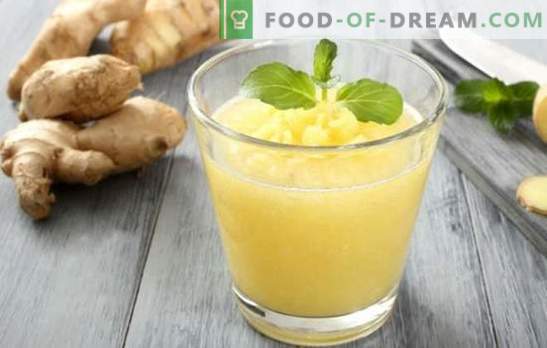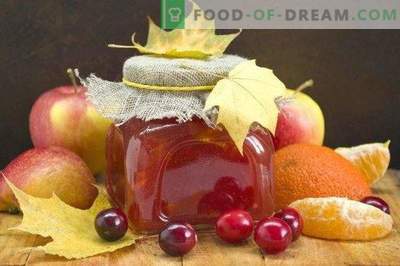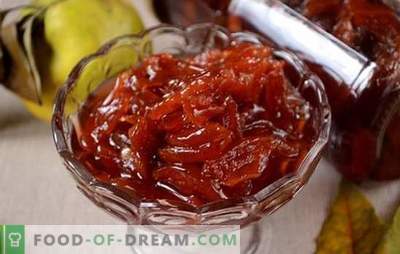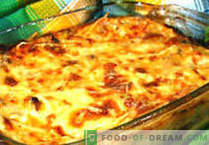
Jam - a dessert that is common in Eastern Europe, is considered to be the traditional sweetness of Russian cuisine. Ginger as a spicy aromatic additive to jam, drinks and sweets, appeared in Russia, approximately from the time of the journey of Afanasy Nikitin, and the exotic root, like many other overseas spices, became one of the favorite spices. At that time there were no airplanes, and therefore, due to the length of travel and transportation, ginger could get into the territory of modern Russia only as dried ground powder, but these details are not described in old recipes, but only follow from the logic of circumstances.
There is another version of the later appearance of ginger jam in Slavic cuisine, according to which Nostradamus, who lived in the first half of the sixteenth century, invented the jam. Perhaps the famous alchemist had his suppliers of spices, but, unfortunately, his recipe for ginger jam was not preserved either.
The beginning of the nineteenth century coincides with the expansion of the French empire and the emergence of French colonies in India and other Asian countries where ginger, by then, had been widely used in cooking and medicine for hundreds of years. The exotic root, according to the third version, came to Western Europe with French or British colonists, and from there, after the fall of Napoleon, impoverished French rentiers, who were looking for a better life and opportunity to earn in Russia as teachers or cooks, brought ginger to the court of Russian emperors. But even at this time it is unlikely that ginger was delivered fresh to Europe.
No matter how it is, ginger jam has been around for a long time, and still continues to be of interest to real gourmets. But, if the appearance of ginger root in Europe is a mystery of the past, then the technology of making ginger jam, despite the unlimited informational possibilities of modern housewives, “armed” with gadgets, continues to grow into funny details, sometimes even contradicting the laws of chemistry and physics, and not just food technology . Let's try to figure out what ginger jam is by focusing on its preparation, known to our distant ancestors.
Ginger jam - the basic technological principles
The Internet is full of recipes, where it is advised to rub ginger, cut oranges or lemons into slices, mix fruit and ginger puree with honey, and keep this “jam” in the refrigerator. The recipe is very tasty and healthy, but this is not jam.
First, the word “jam” means the cooking process. Secondly, the technology of making jam involves boiling whole fruits in sugar syrup. The crushed raw fruits with honey, from the point of view of technology of preparation, are not called jam.
Now - about sugar. Sugar syrup is one of the main components of jam. Honey in combination with non-boiled fruit can easily move into the fermentation phase, and therefore fruit and honey can be made in small quantities, and this dessert, unlike jam, cannot be prepared in advance. Of course, you can cook jam with honey, as our ancestors did when sugar cost more than honey. But in the process of cooking an expensive and valuable product will lose almost all of its beneficial properties, and therefore it is better to use cheaper sugar to produce syrup.
The next thing that matters when cooking ginger jam is root properties. They need to be known in detail to get high-quality and tasty jam.
Some varieties of jam, and more specifically, spicy fruit sauces, exist in Asian cuisine, where ginger root is used mostly fresh. Residents of temperate and northern latitudes with supplies of young ginger root, growing only in exotic countries, had little luck: in the supermarkets of the European part of the continent only mature ginger roots are sold, which have a pronounced lemon shade, dense and even hard fiber pulp, a pleasant peculiar smell and spicy taste.
It is the stiffness that prevents the use of ginger root for making jam all, without residue, as it does not become softer even during the cooking process, like young roots with almost white flesh, without fibers. Mature ginger roots have a more pronounced ginger smell and sharpness. The brighter ginger flavor of the jam is obtained by using the root, and therefore, it is necessary to add ground dry ginger in larger quantities. But in any case, ginger is among the hot spices, and it is necessary to add it to the jam carefully - it is better to try the product at intermediate stages of cooking. The membrane, veins and rind of some citruses contain bitterness. Therefore, before cooking jam from citrus fruits with ginger, they must be thoroughly cleaned, after removing the uppermost thin layer of zest, which, in conjunction with the ginger smell, will give the jam a unique flavor.
Finally, to get a thick syrup for ginger jam, use additives in the form of fruits that contain large amounts of pectin: apples, currants, gooseberries, watermelons, quinces, pumpkins, some varieties of pears, persimmons, citrus peel. Such additives will give jam and additional benefits, and new flavors, depending on the combinations used.
Pectin can be replaced by agar, extract from seaweed, if you use a fast method of cooking jam, with preservation of the maximum of vitamins and the natural flavor of the fruit.
Oranges and ginger jam with vanilla
Composition:
Sugar 1.5 kg
Oranges 6 pcs.
Vanilla 10g
Ginger 120g
700 ml purified water
Cooking Procedure:
Cut the zest from the washed oranges, cut into strips. Peeled fruits are divided into slices. Put the orange zest in the jar, close the lid and put it in the fridge - it will be needed at the very last stage of cooking the jam.
Boil water, and, adding sugar, boil the syrup until the sample is “on a thick string”. Do not forget to remove the foam when cooking syrup.
Pierce the slices of oranges with a needle and put in boiling syrup. Boil for 5 minutes and set aside the dishes with the jam. The next day, rub the ginger root and cover it with a glass of boiling water. It is better to brew it in a thermos and leave for a day. Boil the jam again, and again set aside until the next day. Taz cover with gauze or cotton towel. On the third day, pour out the infusion of ginger root from a thermos, strain and squeeze it through a linen cloth, add to the jam along with vanilla and zest, cook for 5-7 minutes. Put the prepared hot jam in dry sterile jars. After cooling, sprinkle the top layer with sugar and tighten the lids. Jam can be stored at room temperature.
Lemon and ginger jam with nutmeg pumpkin
Composition: Pumpkin, Muscat 1.5 kg (net)
Sugar 1.3 kg
Water 400 ml
Lemons 4 pcs.
Ginger 170g
Cooking Method:
Cut the prepared pumpkin into bars. Boil the water and brew the grated ginger. Pour the pieces of pumpkin and slices of lemons with sugar, leave for a day to make the juice stand out. Before cooking, filtering the ginger infusion, pour it into a bowl, cook the pumpkin with lemons until transparent on low heat, removing the foam.
Pack ready-made jam hot - in hot sterile and dry jars. If you plan to store in the cold, you can not sterilize the jars before closing.
Lemon and ginger jam with paradise apples
Ingredients:
Ginger root 200 g
Ground cinnamon 7 g
Paradise apples 1.8 kg
Sugar 1.2 kg
Lemon juice 250 ml and two lemon peel
Purified water 0.7 l
Working order:
Prepare the apples: cut the stalks, wash and pierce the skin of the fruit. Rub cleaned and washed ginger. Remove the zest from fresh lemons. Put all prepared ingredients in a basin, add sugar and hot water. Heat the jam to a boil, cool. The next day, add ground cinnamon, cook until ready (the jam should be transparent and the syrup thick). Pour in lemon juice, bring to a boil. Pack in prepared jars. Pasteurize for 10 minutes (0.5 ml), roll and wrap.
Jam from oranges and ginger with feijoa
Products:
Crystalline sugar (refined) 2.5 kg
Oranges 1.5 kg
Feijoa 1.0 kg
Ginger 350g
Citric acid 10 g (if the oranges are sweet)
Water 1.0 l
Cooking Technology:
Dense fruits feijoa wash, cut into four parts. Peel the ginger to the core (approximately 100 g will remain). Dry the fibrous pulp and then use to prepare other dishes, and cut the core into very thin straws for jam.
Remove the zest from the oranges and also thinly slice. Carefully peeled citrus slices put in a bowl for boiling jam, along with feijoa, puncturing them with a needle. Add orange zest and ginger here. Pour the fruit on top of half the cooked sugar and leave the bowl for 12-24 hours until you release the juice. Meanwhile, from the second half of the sugar and water, boil a clear syrup, removing the froth during cooking, add citric acid dissolved in a spoon of boiling water (the jam will not evaporate during storage). Pour hot syrup into a bowl of fruit, gently stirring with a wooden spatula, until sugar is completely dissolved, and cook. As usual, remove the foam, scrubbing the fruit on low heat for five minutes. Leave the pelvis to cool. Cover with a towel. Boil for the next two days, also no more than five minutes. On the third day, boil the jam and pack it in dry, hot jars and seal them as soon as the jam cools.
Lemon and ginger jam with pear
Composition:
Winter pears 1.8 kg
Lemon juice and zest of three lemons
Vanilla stick 1 - 2 pcs.
Ground ginger 3 tsp.
Refined sugar 1.5 kg
Saffron? hl
Boiling water 150 ml
Cooking Procedure:
For cooking, select the hard pears of winter varieties, technical ripeness. Without cutting off the skin, remove them from the core, cutting the fruit into 6-8 parts, slices. Remove the zest from the lemons and squeeze the juice out of them; add to the pears and add sugar to the fruit. Leave for a while to stand out juice. Cook for 3 days for five to seven minutes. On the third day of cooking, add saffron, brewed in boiling water, ginger and vanilla stick (or crystalline vanilla powder). Boil for 5 minutes, remove the vanilla pod with a slotted spoon, and pack the jam in cooked jars.
Oranges and ginger jam with cones
Composition:
Sugar 2.5 kg
Oranges 1.5 kg
Pine cones 1.0 kg
Ginger root 250 g
Water 0.8 l
Cooking:
In the middle of May or in the first half of June, away from the city limits, collect pine cones. They should be soft, “milky” ripeness so that it can be easily cut with a knife.
At home wash the cones well, cut them in half or in four parts, cover with water for a day. It should cover the bumps 2-3 cm above the level. Cover the surface with a plate and set the socket so that the bumps do not float. For cooking jam, use stainless dishes. Boil the cones in the same water for half an hour.
Simultaneously with soaking the cones, in another bowl, fold the peeled slices of oranges, puncturing them with a needle, so that they let the juice in. Add the peeled orange peel and grated ginger root. In a bowl of oranges and ginger, pour the sugar. For the first time, in a day, boil the oranges separately from the cones. Boil need to transparency, removing the foam. If the juice is not enough, add part of the infusion of the cones. Then combine both masses, when cool, mix with a wooden spoon or spatula. Boil everything together and pour the jam into jars.
Ginger jam - tips and helpful tips
Ideal for cooking jam - a basin of copper. If there is no such dish, use an enamel bowl or stainless steel bowl.
In order not to burn the jam, use steam boiling. Cooking jam will take a little time, but you can avoid the unpleasant and tedious procedure of cleaning the pelvis, and the jam will not smell like burnt syrup. Only in the basin with water, do not forget to periodically add hot water in the cooking process.
In the finished jam, the berries in the syrup are distributed evenly, and the syrup becomes transparent.
If the finished jam is not subjected to pasteurization, then cover it with lids after it cools. Hot jam under the lid forms a condensate that promotes the formation of mold during storage.























